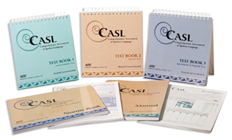 When many of us think of such labels as “language disorder” or “learning disability”, very infrequently do adolescents (students 13-18 years of age) come to mind. Even today, much of the research in the field of pediatric speech pathology involves preschool and school-aged children under 12 years of age.
When many of us think of such labels as “language disorder” or “learning disability”, very infrequently do adolescents (students 13-18 years of age) come to mind. Even today, much of the research in the field of pediatric speech pathology involves preschool and school-aged children under 12 years of age.
The prevalence and incidence of language disorders in adolescents is very difficult to estimate due to which some authors even referred to them as a Neglected Group with Significant Problems having an “invisible disability“.
Far fewer speech language therapists work with middle-schoolers vs. preschoolers and elementary aged kids, while the numbers of SLPs working with high-school aged students is frequently in single digits in some districts while being completely absent in others. In fact, I am frequently told (and often see it firsthand) that some administrators try to cut costs by attempting to dictate a discontinuation of speech-language services on the grounds that adolescents “are far too old for services” or can “no longer benefit from services”.
But of course the above is blatantly false. Undetected language deficits don’t resolve with age! They simply exacerbate and turn into learning disabilities. Similarly, lack of necessary and appropriate service provision to children with diagnosed language impairments at the middle-school and high-school levels will strongly affect their academic functioning and hinder their future vocational outcomes.
A cursory look at the Speech Pathology Related Facebook Groups as well as ASHA forums reveals numerous SLPs in a continual search for best methods of assessment and treatment of older students (~12-18 years of age).
Consequently, today I wanted to dedicate this post to a review of standardized assessments options available for students 12-18 years of age with suspected language and literacy deficits.
Most comprehensive standardized assessments, “typically focus on semantics, syntax, morphology, and phonology, as these are the performance areas in which specific skill development can be most objectively measured” (Hill & Coufal, 2005, p 35). Very few of them actually incorporate aspects of literacy into its subtests in a meaningful way. Yet by the time students reach adolescence literacy begins to play an incredibly critical role not just in all the aspects of academics but also social communication.
So when it comes to comprehensive general language testing I highly recommended that SLPs select standardized measures with a focus on not language but also literacy. Presently of all the comprehensive assessment tools I highly prefer the Test of Integrated Language and Literacy (TILLS) for students up to 18 years of age, (see a comprehensive review HERE), which covers such literacy areas as phonological awareness, reading fluency, reading comprehension, writing and spelling in addition to traditional language areas as as vocabulary awareness, following directions, story recall, etc. However, while comprehensive tests have numerous uses, their sole administration will not constitute an adequate assessment.
So what areas should be assessed during language and literacy testing? Below are a few suggestions of standardized testing measures (and informal procedures) aimed at exploring the student abilities in particular areas pertaining to language and literacy.
TESTS OF LANGUAGE
- Listening Comprehension (for stories not just sentences)
- The Listening Comprehension Test-Adolescent (up to 18 years of age)
- Can be supplemented with informal listening comprehension assessment by giving the students grade level passages
- The Listening Comprehension Test-Adolescent (up to 18 years of age)
- Comprehension of Ambiguous and Figurative Language (e.g., idioms, ambiguous expressions, etc.)
- Clinical Evaluation of Language Fundamentals -5 Metalinguistics (up to 22 years of age)
- Semantic Flexibility (e.g., generation of definitions, synonyms, antonyms, multiple meaning words, etc.)
- WORD Test 2 Adolescent (up to 18 years of age)
- Can be supplemented with informal narrative assessment to determine if the student coherently and cohesively summarize expository or narrative texts
- WORD Test 2 Adolescent (up to 18 years of age)
- Critical Thinking and Problem Solving
- TOPS-2 Adolescent Test of Problem Solving-2 (up to 18 years of age)
- Social Communication
- Social Language Development Test Adolescent (up to 18 years of age)
- Clinical Assessment of Pragmatics (CAPs)
- Can be supplemented with informal assessment of social communication Informal Social Thinking Dynamic Assessment Protocol®)
- Executive Function
- Informal use of Situational Awareness STOP Observation Tool (Ward & Jacobsen, 2014)
- Phonological Awareness
- Comprehensive Test of Phonological Processing-2 (CTOPP-2) (up to 25 years of age)
- Word Fluency
- Rapid Automatized Naming/Rapid Alternating Stimulus RAN/RAS (up to 18 years of age)
- Reading Fluency
- GORT-5: Gray Oral Reading Tests−Fifth Edition (up to 24 years of age)
- The Test of Silent Word Reading Fluency (TOSWRF-2) (up to 25 years of age)
- Test of Silent Contextual Reading Fluency (TOSCRF-2) (up to 25 years of age)
- Reading Comprehension
- Spelling
- Writing
- TOWL-4: Test of Written Language–Fourth Edition (up to 18 years of age)
- Can be informally supplemented with the use of Grade Rubrics addressing Persuasive/Expository Texts
- TOWL-4: Test of Written Language–Fourth Edition (up to 18 years of age)
It is understandable how given the sheer amount of assessment choices some clinicians may feel overwhelmed and be unsure regarding the starting point of an adolescent evaluation. Consequently, the use the checklist prior to the initiation of assessment may be highly useful in order to identify potential language weaknesses/deficits the students might experience. It will also allow clinicians to prioritize the hierarchy of testing instruments to use during the assessment.
While clinicians are encouraged to develop such checklists for their personal use, those who lack time and opportunity can locate a number of already available checklists on the market.
For example, the comprehensive 6-page Speech Language Assessment Checklist for Adolescents (below) can be given to caregivers, classroom teachers, and even older students in order to check off the most pressing difficulties the student is experiencing in an academic setting.
It is important for several individuals to fill out this checklist to ensure consistency of deficits, prior to determining whether an assessment is warranted in the first place and if so, which assessment areas need to be targeted.
Checklist Categories:
- Receptive Language

- Memory, Attention and Cognition
- Expressive Language
- Vocabulary
- Discourse
- Speech
- Voice
- Prosody
- Resonance
- Reading
- Writing
- Problem Solving
- Pragmatic Language Skills
- Social Emotional Development
- Executive Functioning
Based on the checklist administration SLPs can reliably pinpoint the student’s areas of deficits without needless administration of unrelated/unnecessary testing instruments. For example, if a student presents with deficits in the areas of problem solving and social pragmatic functioning the administration of a general language test such as the Clinical Evaluation of Language Fundamentals® – Fifth Edition (CELF-5) would NOT be functional (especially if the previous administration of educational testing did not reveal any red flags). In contrast, the administration of such tests as Test Of Problem Solving 2 Adolescent and Social Language Development Test Adolescent would be better reflective of the student’s deficits in the above areas. (Checklist HERE; checklist sample HERE).
It is very important to understand that students presenting with language and literacy deficits will not outgrow these deficits on their own. While there may be “a time period when the students with early language disorders seem to catch up with their typically developing peers” (e.g., illusory recovery) by undergoing a “spurt” in language learning”(Sun & Wallach, 2014). These spurts are typically followed by a “post-spurt plateau”. This is because due to the ongoing challenges and an increase in academic demands “many children with early language disorders fail to “outgrow” these difficulties or catch up with their typically developing peers”(Sun & Wallach, 2014). As such many adolescents “may not show academic or language-related learning difficulties until linguistic and cognitive demands of the task increase and exceed their limited abilities” (Sun & Wallach, 2014). Consequently, SLPs must consider the “underlying deficits that may be masked by early oral language development” and “evaluate a child’s language abilities in all modalities, including pre-literacy, literacy, and metalinguistic skills” (Sun & Wallach, 2014).
References:
- Hill, J. W., & Coufal, K. L. (2005). Emotional/behavioral disorders: A retrospective examination of social skills, linguistics, and student outcomes. Communication Disorders Quarterly, 27(1), 33–46.
- Sun, L & Wallach G (2014) Language Disorders Are Learning Disabilities: Challenges on the Divergent and Diverse Paths to Language Learning Disability. Topics in Language Disorders, Vol. 34; (1), pp 25–38.
Helpful Smart Speech Therapy Resources
- Assessment of Adolescents with Language and Literacy Impairments in Speech Language Pathology
- Assessment and Treatment Bundles
- Social Communication Materials
- Multicultural Materials


 Today I’d like to officially introduce a new
Today I’d like to officially introduce a new  Recently, I’ve published an article in
Recently, I’ve published an article in  In my social pragmatic language groups I target a wide variety of social communication goals for children with varying levels and degrees of impairment with a focus on improving their social pragmatic language competence. In the past I have written blog posts on a variety of social pragmatic language therapy topics, including strategies for
In my social pragmatic language groups I target a wide variety of social communication goals for children with varying levels and degrees of impairment with a focus on improving their social pragmatic language competence. In the past I have written blog posts on a variety of social pragmatic language therapy topics, including strategies for 

 Our ability to recognize our own and other people’s emotions, distinguish between and correctly identify different feelings, as well as use that information to guide our thinking and behavior is called Emotional Intelligence (EI) (Salovey, et al, 2008).
Our ability to recognize our own and other people’s emotions, distinguish between and correctly identify different feelings, as well as use that information to guide our thinking and behavior is called Emotional Intelligence (EI) (Salovey, et al, 2008).



 One common difficulty our “higher functioning” (refers to subjective notion of ‘perceived’ functioning in school setting only) language impaired students with social communication and executive function difficulties present with – is lack of insight into own strengths and weaknesses.
One common difficulty our “higher functioning” (refers to subjective notion of ‘perceived’ functioning in school setting only) language impaired students with social communication and executive function difficulties present with – is lack of insight into own strengths and weaknesses.

 Graduation time is rapidly approaching and many graduate speech language pathology students are getting ready to begin their first days in the workforce. When it comes to juggling caseloads and managing schedules, time is money and efficiency is the key to success. Consequently, a few years ago I created SLP Efficiency Bundles™, which are materials highly useful for Graduate SLPs working with pediatric clients. These materials are organized by areas of focus for efficient and effective screening, assessment, and treatment of speech and language disorders.
Graduation time is rapidly approaching and many graduate speech language pathology students are getting ready to begin their first days in the workforce. When it comes to juggling caseloads and managing schedules, time is money and efficiency is the key to success. Consequently, a few years ago I created SLP Efficiency Bundles™, which are materials highly useful for Graduate SLPs working with pediatric clients. These materials are organized by areas of focus for efficient and effective screening, assessment, and treatment of speech and language disorders.  Frequently, I see a variation of the following scenario on many speech and language forums.
Frequently, I see a variation of the following scenario on many speech and language forums. Let’s begin by answering a few simple questions. Was a thorough language evaluation with an emphasis on the child’s social pragmatic language abilities been completed? And by thorough, I am not referring to general language tests but to a variety of formal and informal social pragmatic language testing (read more
Let’s begin by answering a few simple questions. Was a thorough language evaluation with an emphasis on the child’s social pragmatic language abilities been completed? And by thorough, I am not referring to general language tests but to a variety of formal and informal social pragmatic language testing (read more  Please note that none of the general language tests such as the Preschool Language Scale-5 (PLS-5), Comprehensive Assessment of Spoken Language (CASL-2), the Test of Language Development-4 (TOLD-4) or even the Clinical Evaluation of Language Fundamentals Tests (CELF-P2)/ (CELF-5) tap into the child’s social language competence because they do NOT directly test the child’s social language skills (e.g., CELF-5 assesses them via a parental/teachers questionnaire). Thus, many children can attain average scores on these tests yet still present with pervasive social language deficits. That is why it’s very important to thoroughly assess social pragmatic language abilities of all children (no matter what their age is) presenting with behavioral deficits.
Please note that none of the general language tests such as the Preschool Language Scale-5 (PLS-5), Comprehensive Assessment of Spoken Language (CASL-2), the Test of Language Development-4 (TOLD-4) or even the Clinical Evaluation of Language Fundamentals Tests (CELF-P2)/ (CELF-5) tap into the child’s social language competence because they do NOT directly test the child’s social language skills (e.g., CELF-5 assesses them via a parental/teachers questionnaire). Thus, many children can attain average scores on these tests yet still present with pervasive social language deficits. That is why it’s very important to thoroughly assess social pragmatic language abilities of all children (no matter what their age is) presenting with behavioral deficits.






